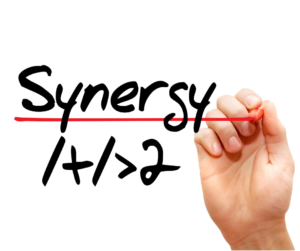 In mergers and acquisitions (M&As), there are some buyers who are willing to pay a premium above the fair market value of the business on a controlling basis. This premium typically is the result of cost-saving or revenue-building synergies that a specific buyer can potentially gain by acquiring the seller’s business.
In mergers and acquisitions (M&As), there are some buyers who are willing to pay a premium above the fair market value of the business on a controlling basis. This premium typically is the result of cost-saving or revenue-building synergies that a specific buyer can potentially gain by acquiring the seller’s business.
When selling a business, it makes sense to find a buyer who’s willing to pay the highest possible price. Here’s some guidance to help identify synergistic buyers and establish a reasonable asking price.
What is Synergistic Value?
According to the International Valuation Glossary — Business Valuation, synergistic value is “the result of a combination of two or more assets or interests where the combined value is more than the sum of the separate values.” This often results from economies of scale (cost savings of being part of a larger entity). But it can also come from cross-selling opportunities or strategic advantages.
Examples of potential synergistic buyers include:
- Competitors looking to build market share,
- Joint venture partners who already understand the business model, and
- Vertically integrated supply chain partners (such as suppliers, brokers or customers) who can operate more efficiently.
For instance, in a highly competitive sector, a large company might be willing to pay a 10% premium above fair market value to purchase a competitor and expand its market share. This buyer is using a roll-up strategy to become the dominant player in the industry. Eventually, the buyer expects to exert significant control over its supply chain, allowing it to recoup acquisition costs through higher prices and lower costs.
How to Value Synergies?
Discounted cash flow models are typically used to estimate synergistic value. Here, the valuator uses buyer-specific assumptions to estimate cash flows. In contrast, when estimating fair market value, the expert relies on assumptions that apply to the universe of all hypothetical buyers and sellers.
The models for estimating synergistic value can sometimes be complicated. For example, valuators may assign different types of synergies into separate “buckets” and assess them separately according to risk. They might apply a higher discount rate or reduce cash flow projections to reflect the risk that synergies won’t be achieved.
The level of analysis depends in part on the nature and risk of the synergies. For example, easily achieved cost synergies — such as those derived from eliminating redundant management — might not require a separate valuation. But revenue synergies, such as those derived from cross-selling to a new customer base or sharing distribution channels, might need to be treated separately, given the higher risk involved.
Get It Right
Valuing synergies can be challenging, especially in today’s uncertain markets. Before you put your business up for sale, consult an experienced valuation specialist to help you identify potential synergistic buyers, as well as develop reasonable, market-based financial projections and discount rates. Contact us for more information.
© 2022

Principal
james.horkey@hwco.cpa




